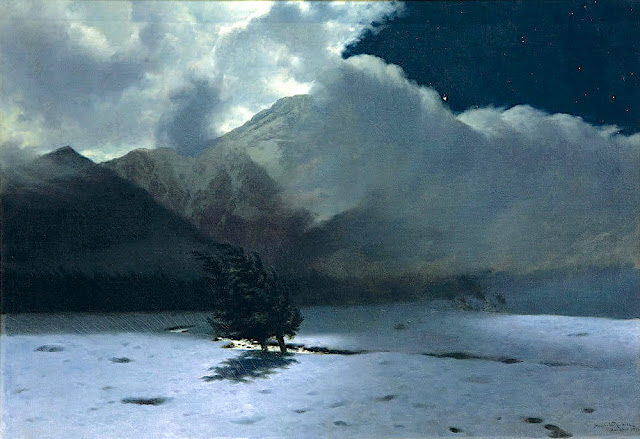The Rysy (2,503 m -8,212 ft)
Poland - Slovakia border
In Halny Wind in Tatra Mountains, 1885, oil on canvas
About this painting
Halny is a foehn wind that blows in southern Poland and in Slovakia in the Tatra Mountains of the Carpathians. The most turbulent halny blows in Podhale region of southern Poland, coming from the south, down the slopes of the Tatra Mountains; in Slovakia, on the other side of the mountains, it comes from the north. Halny is a warm windstorm that blows through the valleys. It is often disastrous; ripping off roofs, causing avalanches and, according to some people, can have some influence on mental states. Most halny occur in October and November, sometimes in February and March, rarely in other months. In May 1968 a destructive halny known as Wind of the Century where winds reportedly reached 288 km/h, destroyed large areas of forestry in southern Poland.
The mountain
The Rysy (2,503 m -8,212 ft), the the highest point in Poland. named Meeraugspitze in German and Tengerszem-csúcs in Hungarian is a mountain in the crest of the High Tatras, lying on the border between Poland and Slovakia. Rysy has three summits: the middle at 2,503 m (8,212 ft); the north-western at 2,499 m (8,199 ft); and the south-eastern at 2,473 m (8,114 ft). The north-western summit is the highest point of Poland ; the other two summits are on the Slovak side of the border, in the Prezov Region. A folk explanation on the Slovak side says that the name comes from the plural word rysy meaning "lynxes", although the habitat of the lynx does not extend above the timberline.
The Hungarian name Tengerszem-csúcs and the German name Meeraugspitze mean "eye-of-the-sea peak", from the glacial lake at the northern foot of the mountain, called "eye of the sea" (Morskie Oko in Polish). Morskie Oko (literally Eye of the Sea") is the largest and fourth-deepest lake (50, 8 m - 166 ft) in the Tatra Mountains. It is located deep within the Tatra National Park, in the Rybi Potok Valley, of the High Tatras mountain range at a n altitude of 1,395m - 4,577ft.
Many Swiss Pines also grow around the lake as shown in this painting.
The artist
Stanisław Witkiewicz was a Polish painter, art theoretician, and amateur architect, known for his creation of "Zakopane Style". He studied at the Academy of Fine Arts in Saint Petersburg (1868–1871) and furthered his studies in Munich (1872–1875). In 1875, he moved to Warsaw and set up a painting workshop in the laundry at the Hotel Europejski. In 1884–1887, Witkiewicz worked as the artistic director of "Wędrowiec" weekly, for which he wrote a series of articles concerning the values of a work of art and the role of art critics (published in book form under the title "Painting and criticism among us", in 1891 and 1899). In 1887, he held the same position in "Kłosy" magazine.
In 1886, he visited Zakopane for the first time. He developed a fascination with the mountains, the Podhale highlanders and their vernacular traditions. His ambition became to create a Polish national style through extraction of all-Polish forms from the architectural and decorative art of the highlanders. He formulated the Zakopane Style (styl zakopiański) (also known as Witkiewicz Style in architecture, in which he designed homes and interiors for well-off, artistically inclined Poles. He was strongly associated with Zakopane and promoted it in the art community. Witkiewicz had strong views against formal education: "school is completely at odds with the psychological make-up of human beings". He applied this principle in his son's upbringing and was disappointed when the 20-year-old Witkacy chose to enroll at the Academy of Fine Arts in Kraków. In 1908, suffering from tuberculosis, the elder Witkiewicz left his family in Zakopane and relocated to Lovran, a fashionable resort in what was then Austria-Hungary, which today is in Croatia. He died there in 1915.
_______________________________
2021 - Wandering Vertexes...
by Francis Rousseau

